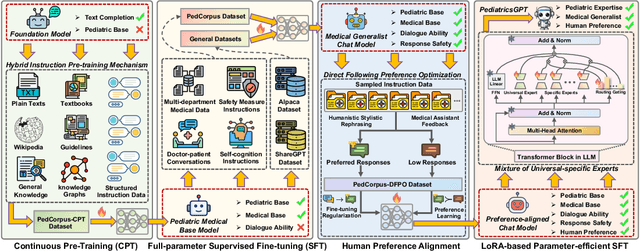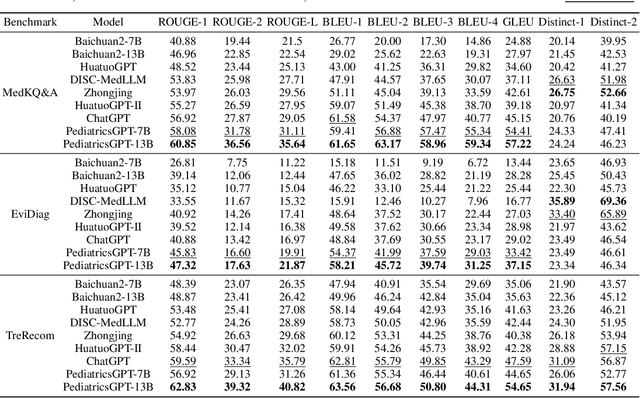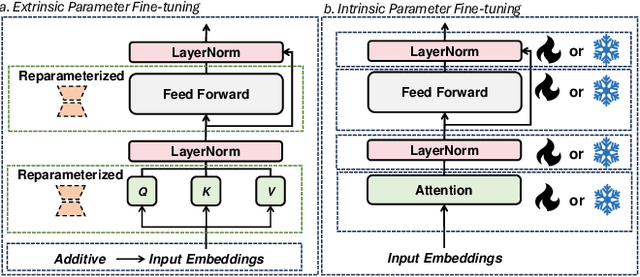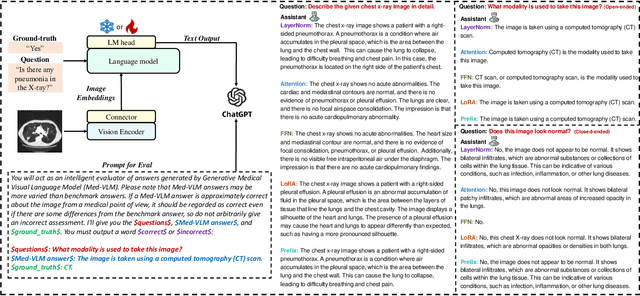Jinjie Wei
MedQ-Bench: Evaluating and Exploring Medical Image Quality Assessment Abilities in MLLMs
Oct 02, 2025Abstract:Medical Image Quality Assessment (IQA) serves as the first-mile safety gate for clinical AI, yet existing approaches remain constrained by scalar, score-based metrics and fail to reflect the descriptive, human-like reasoning process central to expert evaluation. To address this gap, we introduce MedQ-Bench, a comprehensive benchmark that establishes a perception-reasoning paradigm for language-based evaluation of medical image quality with Multi-modal Large Language Models (MLLMs). MedQ-Bench defines two complementary tasks: (1) MedQ-Perception, which probes low-level perceptual capability via human-curated questions on fundamental visual attributes; and (2) MedQ-Reasoning, encompassing both no-reference and comparison reasoning tasks, aligning model evaluation with human-like reasoning on image quality. The benchmark spans five imaging modalities and over forty quality attributes, totaling 2,600 perceptual queries and 708 reasoning assessments, covering diverse image sources including authentic clinical acquisitions, images with simulated degradations via physics-based reconstructions, and AI-generated images. To evaluate reasoning ability, we propose a multi-dimensional judging protocol that assesses model outputs along four complementary axes. We further conduct rigorous human-AI alignment validation by comparing LLM-based judgement with radiologists. Our evaluation of 14 state-of-the-art MLLMs demonstrates that models exhibit preliminary but unstable perceptual and reasoning skills, with insufficient accuracy for reliable clinical use. These findings highlight the need for targeted optimization of MLLMs in medical IQA. We hope that MedQ-Bench will catalyze further exploration and unlock the untapped potential of MLLMs for medical image quality evaluation.
MCCD: Multi-Agent Collaboration-based Compositional Diffusion for Complex Text-to-Image Generation
May 05, 2025Abstract:Diffusion models have shown excellent performance in text-to-image generation. Nevertheless, existing methods often suffer from performance bottlenecks when handling complex prompts that involve multiple objects, characteristics, and relations. Therefore, we propose a Multi-agent Collaboration-based Compositional Diffusion (MCCD) for text-to-image generation for complex scenes. Specifically, we design a multi-agent collaboration-based scene parsing module that generates an agent system comprising multiple agents with distinct tasks, utilizing MLLMs to extract various scene elements effectively. In addition, Hierarchical Compositional diffusion utilizes a Gaussian mask and filtering to refine bounding box regions and enhance objects through region enhancement, resulting in the accurate and high-fidelity generation of complex scenes. Comprehensive experiments demonstrate that our MCCD significantly improves the performance of the baseline models in a training-free manner, providing a substantial advantage in complex scene generation.
Toward Robust Incomplete Multimodal Sentiment Analysis via Hierarchical Representation Learning
Nov 05, 2024



Abstract:Multimodal Sentiment Analysis (MSA) is an important research area that aims to understand and recognize human sentiment through multiple modalities. The complementary information provided by multimodal fusion promotes better sentiment analysis compared to utilizing only a single modality. Nevertheless, in real-world applications, many unavoidable factors may lead to situations of uncertain modality missing, thus hindering the effectiveness of multimodal modeling and degrading the model's performance. To this end, we propose a Hierarchical Representation Learning Framework (HRLF) for the MSA task under uncertain missing modalities. Specifically, we propose a fine-grained representation factorization module that sufficiently extracts valuable sentiment information by factorizing modality into sentiment-relevant and modality-specific representations through crossmodal translation and sentiment semantic reconstruction. Moreover, a hierarchical mutual information maximization mechanism is introduced to incrementally maximize the mutual information between multi-scale representations to align and reconstruct the high-level semantics in the representations. Ultimately, we propose a hierarchical adversarial learning mechanism that further aligns and adapts the latent distribution of sentiment-relevant representations to produce robust joint multimodal representations. Comprehensive experiments on three datasets demonstrate that HRLF significantly improves MSA performance under uncertain modality missing cases.
MedAide: Towards an Omni Medical Aide via Specialized LLM-based Multi-Agent Collaboration
Oct 17, 2024



Abstract:Large Language Model (LLM)-driven interactive systems currently show potential promise in healthcare domains. Despite their remarkable capabilities, LLMs typically lack personalized recommendations and diagnosis analysis in sophisticated medical applications, causing hallucinations and performance bottlenecks. To address these challenges, this paper proposes MedAide, an LLM-based omni medical multi-agent collaboration framework for specialized healthcare services. Specifically, MedAide first performs query rewriting through retrieval-augmented generation to accomplish accurate medical intent understanding. Immediately, we devise a contextual encoder to obtain intent prototype embeddings, which are used to recognize fine-grained intents by similarity matching. According to the intent relevance, the activated agents collaborate effectively to provide integrated decision analysis. Extensive experiments are conducted on four medical benchmarks with composite intents. Experimental results from automated metrics and expert doctor evaluations show that MedAide outperforms current LLMs and improves their medical proficiency and strategic reasoning.
Improving Factuality in Large Language Models via Decoding-Time Hallucinatory and Truthful Comparators
Aug 22, 2024



Abstract:Despite their remarkable capabilities, Large Language Models (LLMs) are prone to generate responses that contradict verifiable facts, i.e., unfaithful hallucination content. Existing efforts generally focus on optimizing model parameters or editing semantic representations, which compromise the internal factual knowledge of target LLMs. In addition, hallucinations typically exhibit multifaceted patterns in downstream tasks, limiting the model's holistic performance across tasks. In this paper, we propose a Comparator-driven Decoding-Time (CDT) framework to alleviate the response hallucination. Firstly, we construct hallucinatory and truthful comparators with multi-task fine-tuning samples. In this case, we present an instruction prototype-guided mixture of experts strategy to enhance the ability of the corresponding comparators to capture different hallucination or truthfulness patterns in distinct task instructions. CDT constrains next-token predictions to factuality-robust distributions by contrasting the logit differences between the target LLMs and these comparators. Systematic experiments on multiple downstream tasks show that our framework can significantly improve the model performance and response factuality.
PediatricsGPT: Large Language Models as Chinese Medical Assistants for Pediatric Applications
May 29, 2024



Abstract:Developing intelligent pediatric consultation systems offers promising prospects for improving diagnostic efficiency, especially in China, where healthcare resources are scarce. Despite recent advances in Large Language Models (LLMs) for Chinese medicine, their performance is sub-optimal in pediatric applications due to inadequate instruction data and vulnerable training procedures. To address the above issues, this paper builds PedCorpus, a high-quality dataset of over 300,000 multi-task instructions from pediatric textbooks, guidelines, and knowledge graph resources to fulfil diverse diagnostic demands. Upon well-designed PedCorpus, we propose PediatricsGPT, the first Chinese pediatric LLM assistant built on a systematic and robust training pipeline. In the continuous pre-training phase, we introduce a hybrid instruction pre-training mechanism to mitigate the internal-injected knowledge inconsistency of LLMs for medical domain adaptation. Immediately, the full-parameter Supervised Fine-Tuning (SFT) is utilized to incorporate the general medical knowledge schema into the models. After that, we devise a direct following preference optimization to enhance the generation of pediatrician-like humanistic responses. In the parameter-efficient secondary SFT phase, a mixture of universal-specific experts strategy is presented to resolve the competency conflict between medical generalist and pediatric expertise mastery. Extensive results based on the metrics, GPT-4, and doctor evaluations on distinct doctor downstream tasks show that PediatricsGPT consistently outperforms previous Chinese medical LLMs. Our model and dataset will be open-source for community development.
Efficiency in Focus: LayerNorm as a Catalyst for Fine-tuning Medical Visual Language Pre-trained Models
Apr 25, 2024



Abstract:In the realm of Medical Visual Language Models (Med-VLMs), the quest for universal efficient fine-tuning mechanisms remains paramount, especially given researchers in interdisciplinary fields are often extremely short of training resources, yet largely unexplored. Given the unique challenges in the medical domain, such as limited data scope and significant domain-specific requirements, evaluating and adapting Parameter-Efficient Fine-Tuning (PEFT) methods specifically for Med-VLMs is essential. Most of the current PEFT methods on Med-VLMs have yet to be comprehensively investigated but mainly focus on adding some components to the model's structure or input. However, fine-tuning intrinsic model components often yields better generality and consistency, and its impact on the ultimate performance of Med-VLMs has been widely overlooked and remains understudied. In this paper, we endeavour to explore an alternative to traditional PEFT methods, especially the impact of fine-tuning LayerNorm layers, FFNs and Attention layers on the Med-VLMs. Our comprehensive studies span both small-scale and large-scale Med-VLMs, evaluating their performance under various fine-tuning paradigms across tasks such as Medical Visual Question Answering and Medical Imaging Report Generation. The findings reveal unique insights into the effects of intrinsic parameter fine-tuning methods on fine-tuning Med-VLMs to downstream tasks and expose fine-tuning solely the LayerNorm layers not only surpasses the efficiency of traditional PEFT methods but also retains the model's accuracy and generalization capabilities across a spectrum of medical downstream tasks. The experiments show LayerNorm fine-tuning's superior adaptability and scalability, particularly in the context of large-scale Med-VLMs.
Can LLMs' Tuning Methods Work in Medical Multimodal Domain?
Mar 11, 2024



Abstract:While large language models (LLMs) excel in world knowledge understanding, adapting them to specific subfields requires precise adjustments. Due to the model's vast scale, traditional global fine-tuning methods for large models can be computationally expensive and impact generalization. To address this challenge, a range of innovative Parameters-Efficient Fine-Tuning (PEFT) methods have emerged and achieved remarkable success in both LLMs and Large Vision-Language Models (LVLMs). In the medical domain, fine-tuning a medical Vision-Language Pretrained (VLP) model is essential for adapting it to specific tasks. Can the fine-tuning methods for large models be transferred to the medical field to enhance transfer learning efficiency? In this paper, we delve into the fine-tuning methods of LLMs and conduct extensive experiments to investigate the impact of fine-tuning methods for large models on existing multimodal models in the medical domain from the training data level and the model structure level. We show the different impacts of fine-tuning methods for large models on medical VLMs and develop the most efficient ways to fine-tune medical VLP models. We hope this research can guide medical domain researchers in optimizing VLMs' training costs, fostering the broader application of VLMs in healthcare fields. Code and dataset will be released upon acceptance.
Towards Multimodal Human Intention Understanding Debiasing via Subject-Deconfounding
Mar 08, 2024



Abstract:Multimodal intention understanding (MIU) is an indispensable component of human expression analysis (e.g., sentiment or humor) from heterogeneous modalities, including visual postures, linguistic contents, and acoustic behaviors. Existing works invariably focus on designing sophisticated structures or fusion strategies to achieve impressive improvements. Unfortunately, they all suffer from the subject variation problem due to data distribution discrepancies among subjects. Concretely, MIU models are easily misled by distinct subjects with different expression customs and characteristics in the training data to learn subject-specific spurious correlations, significantly limiting performance and generalizability across uninitiated subjects.Motivated by this observation, we introduce a recapitulative causal graph to formulate the MIU procedure and analyze the confounding effect of subjects. Then, we propose SuCI, a simple yet effective causal intervention module to disentangle the impact of subjects acting as unobserved confounders and achieve model training via true causal effects. As a plug-and-play component, SuCI can be widely applied to most methods that seek unbiased predictions. Comprehensive experiments on several MIU benchmarks clearly demonstrate the effectiveness of the proposed module.
Fake Generated Painting Detection via Frequency Analysis
Mar 05, 2020



Abstract:With the development of deep neural networks, digital fake paintings can be generated by various style transfer algorithms.To detect the fake generated paintings, we analyze the fake generated and real paintings in Fourier frequency domain and observe statistical differences and artifacts. Based on our observations, we propose Fake Generated Painting Detection via Frequency Analysis (FGPD-FA) by extracting three types of features in frequency domain. Besides, we also propose a digital fake painting detection database for assessing the proposed method. Experimental results demonstrate the excellence of the proposed method in different testing conditions.
 Add to Chrome
Add to Chrome Add to Firefox
Add to Firefox Add to Edge
Add to Edge